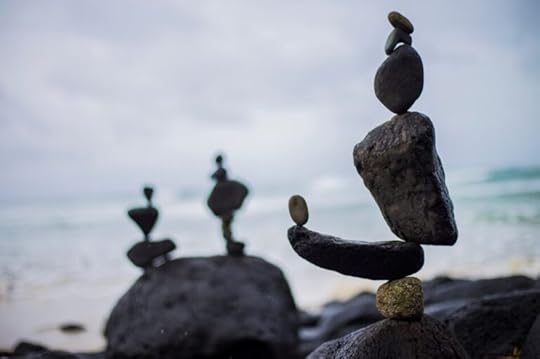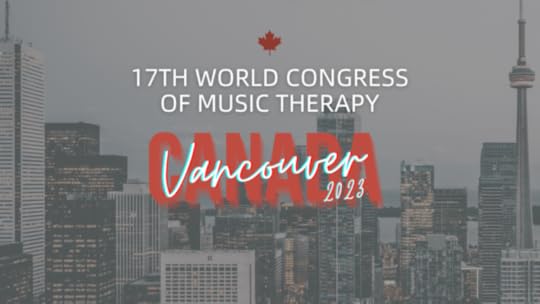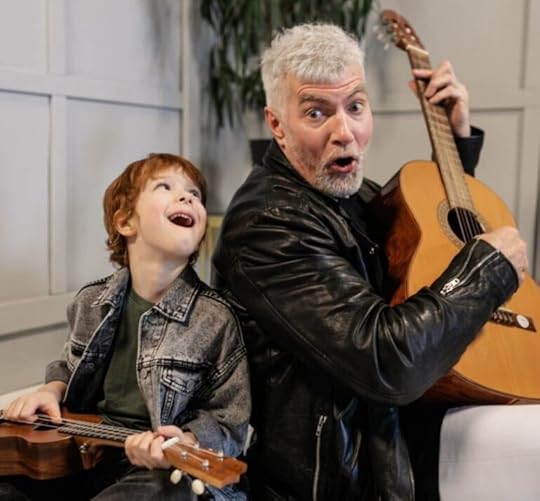Jennifer Buchanan's Blog, page 2
August 7, 2023
Silence Speaks: Discovering Strength in Stillness
Music is a complex and intricate blend of sound and silence.�� Dr. Helen Lees the author of Silence in our Schools goes on to say that ���A natural silence for people to tune into, to develop, to come towards, that is helpful for living and learning, developing and understanding, interacting and knowing. Silence brings peace, healing, joy, simplicity, and truth. It brings about the laying of foundations of understanding.��� In her book, she likens silence to precious resources, something that needs to be sourced in order to capture its power of transformation.
I first experienced true silence during an all-day cross-country ski trip. Being at the back of the pack and knowing I was not in top shape, I went at the back so I didn���t hold anyone up. Occasionally, I stopped after a particularly difficult hill and pretended to adjust my boots, or take off my gloves when in fact I was catching my breath.
During one of those stops, the group in front of me disappeared around a bend in the trail, and suddenly I felt a blast of silence. There was no sound or transfer of vibration or wind in my ears. It made me stop and immediately brought my whole being into clear focus. I felt a reverence for all that was around me, and I made sure not to turn too fast, knowing this feeling would end.
I was not scared. Soothed by silence���s embrace, I felt almost hugged by nature, heard it telling me, ���Here is your moment, enjoy.���
���Jennifer are you okay back there?��� **My friend called back to me. The moment was over. I was sorry to have to respond but wanted to assure all that I could make it (albeit barely) and continued on our trek. Never before had I experienced silence in such a powerful way.
In speech, it is in a moment of silence that one also fully appreciates the intentionality of what has been said. The listener understands that he is being singled out and ���spoken to.��� Silence provides a pocket of space in which the sound just heard can be processed and consciously responded to. It is the listener���s�� opportunity to react and give something in return. Silence can also be used to create anticipation for what comes next.
Music uses silence in the same way���to capture your attention, to lure, to grab hold, to hug, to suspend the listener through a silent pause. **It ensures you escape from sound, leaving room for an even greater impact the next time. By giving you the space you need, it propagates the energy of the music and leaves you hungry, desiring more.
/*! elementor - v3.14.0 - 26-06-2023 */.elementor-widget-image{text-align:center}.elementor-widget-image a{display:inline-block}.elementor-widget-image a img[src$=".svg"]{width:48px}.elementor-widget-image img{vertical-align:middle;display:inline-block}
Exercise: Just Breathe
For those of us who are feeling extra sensitive to sensory stimulation, when just leaving the house in the morning can feel like a challenge here is a short exercise to use.
Breathe.
And that���s it.
The research is clear that three deep breathes can reduce your fight or flight response. By breathing more deeply you can break the cycle of anxiety. Breathing exercises can help reduce tension and relieve stress, thanks to an extra boost of oxygen. While shallow breathing, a marker of stress, stimulates the sympathetic nervous system, deep breathing does the opposite and helps us to calm down.
Did you know that nearly half of all workers suffer from moderate to severe stress while on the job, according to a recent survey. And 66 percent of employees report that they have difficulty focusing on tasks at work because of stress.��Stress has been called the ���health epidemic of the 21 century��� by the World Health Organization and it costs American businesses up to $300 billion a year.
What���s more, breathing exercises have been proven to support the systems that can be harmed by stress. A moment of silence with just deep breathing can reduce blood pressure and may even be able to change the expression of some genes. Everybody has an overwhelm point. It is different for everyone. Many of us just keep pushing through the stress but our goals of accomplishment and productivity become much harder to achieve in this state.�� With the simple act of three deep breathes anywhere you are, you are combating those stress responses and putting your body in a healthier place to better cope with whatever is to come.
/*! elementor - v3.14.0 - 26-06-2023 */.elementor-column .elementor-spacer-inner{height:var(--spacer-size)}.e-con{--container-widget-width:100%}.e-con-inner>.elementor-widget-spacer,.e-con>.elementor-widget-spacer{width:var(--container-widget-width,var(--spacer-size));--align-self:var(--container-widget-align-self,initial);--flex-shrink:0}.e-con-inner>.elementor-widget-spacer>.elementor-widget-container,.e-con-inner>.elementor-widget-spacer>.elementor-widget-container>.elementor-spacer,.e-con>.elementor-widget-spacer>.elementor-widget-container,.e-con>.elementor-widget-spacer>.elementor-widget-container>.elementor-spacer{height:100%}.e-con-inner>.elementor-widget-spacer>.elementor-widget-container>.elementor-spacer>.elementor-spacer-inner,.e-con>.elementor-widget-spacer>.elementor-widget-container>.elementor-spacer>.elementor-spacer-inner{height:var(--container-widget-height,var(--spacer-size))}The post Silence Speaks: Discovering Strength in Stillness first appeared on Jennifer Buchanan.
July 6, 2023
World Congress of Music Therapy Comes to Canada
The World Congress of Music Therapy holds a prestigious status as an internationally acclaimed event, attracting professionals, researchers, educators, and enthusiasts from around the world. In 2023, this highly anticipated congress will be hosted in Canada, providing an exceptional platform for meaningful discussions, knowledge sharing, and experiences centered around the transformative power of music therapy.
/*! elementor - v3.14.0 - 26-06-2023 */.elementor-widget-image{text-align:center}.elementor-widget-image a{display:inline-block}.elementor-widget-image a img[src$=".svg"]{width:48px}.elementor-widget-image img{vertical-align:middle;display:inline-block} /*! elementor - v3.14.0 - 26-06-2023 */.elementor-column .elementor-spacer-inner{height:var(--spacer-size)}.e-con{--container-widget-width:100%}.e-con-inner>.elementor-widget-spacer,.e-con>.elementor-widget-spacer{width:var(--container-widget-width,var(--spacer-size));--align-self:var(--container-widget-align-self,initial);--flex-shrink:0}.e-con-inner>.elementor-widget-spacer>.elementor-widget-container,.e-con-inner>.elementor-widget-spacer>.elementor-widget-container>.elementor-spacer,.e-con>.elementor-widget-spacer>.elementor-widget-container,.e-con>.elementor-widget-spacer>.elementor-widget-container>.elementor-spacer{height:100%}.e-con-inner>.elementor-widget-spacer>.elementor-widget-container>.elementor-spacer>.elementor-spacer-inner,.e-con>.elementor-widget-spacer>.elementor-widget-container>.elementor-spacer>.elementor-spacer-inner{height:var(--container-widget-height,var(--spacer-size))}
/*! elementor - v3.14.0 - 26-06-2023 */.elementor-column .elementor-spacer-inner{height:var(--spacer-size)}.e-con{--container-widget-width:100%}.e-con-inner>.elementor-widget-spacer,.e-con>.elementor-widget-spacer{width:var(--container-widget-width,var(--spacer-size));--align-self:var(--container-widget-align-self,initial);--flex-shrink:0}.e-con-inner>.elementor-widget-spacer>.elementor-widget-container,.e-con-inner>.elementor-widget-spacer>.elementor-widget-container>.elementor-spacer,.e-con>.elementor-widget-spacer>.elementor-widget-container,.e-con>.elementor-widget-spacer>.elementor-widget-container>.elementor-spacer{height:100%}.e-con-inner>.elementor-widget-spacer>.elementor-widget-container>.elementor-spacer>.elementor-spacer-inner,.e-con>.elementor-widget-spacer>.elementor-widget-container>.elementor-spacer>.elementor-spacer-inner{height:var(--container-widget-height,var(--spacer-size))} Why Music Therapy Matters
Music therapy, a holistic approach to healing and well-being, harnesses the unique properties of music to address physical, emotional, cognitive, and social needs. Its effectiveness has been extensively proven in diverse settings such as hospitals, schools, rehabilitation centers, and community programs. Trained music therapists strategically employ music to connect with individuals, helping them navigate challenges, express emotions, and improve their overall quality of life.
Fostering International Collaboration
The upcoming World Congress of Music Therapy in Canada holds significant importance as it provides a platform for professionals and researchers to converge, learn from each other, and advance the field. The congress aims to foster international collaboration, encourage dialogue, and celebrate the diverse perspectives and practices within music therapy. Excitingly, registration for this highly anticipated event is still open, and you can secure your spot here!
Exploring Themes and Focus Areas
The congress will delve into an array of themes and topics to promote extensive knowledge exchange, including:
Therapeutic Applications of Music: Unveiling its Power across Populations and SettingsTechnology Integration: Enhancing Music Therapy PracticeCultural Considerations: Embracing Diversity in Music TherapyMusic Therapy in Mental Health and Well-being: Nurturing Healing HarmoniesThe Future of Music and Music Therapy in Healthcare: Innovating through Rhythmic PathwaysAttendees can anticipate a dynamic program encompassing the latest research findings, experiential learning opportunities, and interactive sessions, ensuring an enriching experience for all.
Networking and Collaboration
An exceptional aspect of the World Congress is the opportunity it offers for networking and collaboration. Attendees will have the chance to connect with industry experts, forge new professional relationships, and establish partnerships that will further advance the field of music therapy. The congress also provides a platform for individuals to share their personal experiences and stories, fostering a sense of community and solidarity among participants.

The upcoming World Congress of Music Therapy in Canada will undoubtedly serve as a landmark event, uniting passionate individuals from every corner of the globe to celebrate the power of music therapy. As professionals, researchers, and enthusiasts come together, they will have the opportunity to exchange knowledge, share insights, and explore innovative approaches to enhance the practice of music therapy. By harnessing the transformative potential of music, this congress will not only benefit the music therapy community but also contribute to the overall well-being of individuals worldwide.
The post World Congress of Music Therapy Comes to Canada first appeared on Jennifer Buchanan.
June 23, 2023
The Top 25 Songs that Empower People!
The role of music in shaping our emotions, perceptions, and even our health cannot be overstated. As I dove into the theme of the Canadian Burn Survivors Conference ��� refocus, renew, refresh ��� I felt in addition to a message about the power of music, the best way to ignite engagement would be to identify the top 25 songs that empower us – as a community (see below)!
Empowerment is the profound process of gaining strength, confidence, and authority over one’s life. It is about self-determination, being in control of your destiny, and having the capacity to shape your world. Empowerment is not just believing you can make a difference; it’s about having the resources and the ability to do so.
 Music as a Pain Disrupter
Music as a Pain DisrupterThink about the role of music in your life, and how it impacts your emotions and your feelings. Now, consider the potential of music in a therapeutic setting. Researchers are continuously finding evidence to suggest music can mitigate pain and anxiety. As you listen to your favourite melody, your body responds, releasing endorphins ��� nature’s own painkillers.
Music can be a distraction, helping us shift our attention away from pain, and offering a comforting presence in times of discomfort.
“Music drowns out the noise���just enough���so you can find some rest.” – John Westhaver
Music can be a refuge. It’s the ability to select a piece of music, construct a playlist or even play an instrument, that provides a sense of agency and control, instilling hope during strenuous treatments and therapies.
Music for Health is not only for PatientsCertified Music Therapists (MTAs) use musical interventions to enhance physical, emotional, cognitive, and social well-being. It’s about empowerment, and enabling patients to play an active role in their healing process.
However, it’s important to note that the power of music isn’t only for the patients. It extends to caregivers and healthcare providers who often work under enormous stress. Music’s calming influence can foster a relaxed, positive environment that promotes enhanced communication and nurtures patient-caregiver relationships.
So, whether you’re a patient or a healthcare provider, let the melodies flow, let the rhythm take over, let the music play its part in your pursuit of greater health and well-being. Let’s renew, refocus, and feel refreshed by the symphony of life – yes, it’s music.
“The Canadian Burn Survivors Community aims to provide support and resources to burn survivors and their caregivers, advocate for the highest level of burn care, promote burn prevention education, foster connections among burn survivors, families and professionals, and encourage research in burn care.”
The post The Top 25 Songs that Empower People! first appeared on Jennifer Buchanan.
June 3, 2023
Harmonizing Generations: When All Ages Explore the Magic of Music Together
Harmonizing Generations: When All Ages Explore the Magic of Music Together
Imagine sitting at a family or friend gathering, with many generations in attendance – from seven to eighty-seven. Imagine while you are sitting around a large table the host asks the simple question:
���What music have you been drawn to lately��� What would YOUR answer be?
Curiosity plays an important role in maintaining cognitive function, mental health, and physical health��in older adults – and there is nothing more fun than being curious about people���s music preferences. The answers may (always) surprise you!
This can be a fun and rewarding experience for everyone involved. In this blog post, we will discuss the benefits of intergenerational music and provide tips on how to engage all ages and abilities into its fun.
/*! elementor - v3.11.5 - 14-03-2023 */.elementor-widget-image{text-align:center}.elementor-widget-image a{display:inline-block}.elementor-widget-image a img[src$=".svg"]{width:48px}.elementor-widget-image img{vertical-align:middle;display:inline-block} /*! elementor - v3.11.5 - 14-03-2023 */.elementor-column .elementor-spacer-inner{height:var(--spacer-size)}.e-con{--container-widget-width:100%}.e-con-inner>.elementor-widget-spacer,.e-con>.elementor-widget-spacer{width:var(--container-widget-width,var(--spacer-size));--align-self:var(--container-widget-align-self,initial);--flex-shrink:0}.e-con-inner>.elementor-widget-spacer>.elementor-widget-container,.e-con-inner>.elementor-widget-spacer>.elementor-widget-container>.elementor-spacer,.e-con>.elementor-widget-spacer>.elementor-widget-container,.e-con>.elementor-widget-spacer>.elementor-widget-container>.elementor-spacer{height:100%}.e-con-inner>.elementor-widget-spacer>.elementor-widget-container>.elementor-spacer>.elementor-spacer-inner,.e-con>.elementor-widget-spacer>.elementor-widget-container>.elementor-spacer>.elementor-spacer-inner{height:var(--container-widget-height,var(--spacer-size))}
/*! elementor - v3.11.5 - 14-03-2023 */.elementor-column .elementor-spacer-inner{height:var(--spacer-size)}.e-con{--container-widget-width:100%}.e-con-inner>.elementor-widget-spacer,.e-con>.elementor-widget-spacer{width:var(--container-widget-width,var(--spacer-size));--align-self:var(--container-widget-align-self,initial);--flex-shrink:0}.e-con-inner>.elementor-widget-spacer>.elementor-widget-container,.e-con-inner>.elementor-widget-spacer>.elementor-widget-container>.elementor-spacer,.e-con>.elementor-widget-spacer>.elementor-widget-container,.e-con>.elementor-widget-spacer>.elementor-widget-container>.elementor-spacer{height:100%}.e-con-inner>.elementor-widget-spacer>.elementor-widget-container>.elementor-spacer>.elementor-spacer-inner,.e-con>.elementor-widget-spacer>.elementor-widget-container>.elementor-spacer>.elementor-spacer-inner{height:var(--container-widget-height,var(--spacer-size))} The Benefits of Intergenerational Music
Social Connection [https://voices.no/index.php/voices/article/view/2536/2301] : Intergenerational music brings people from different age groups together, creating a sense of community and social connection. It provides an opportunity for people to interact with others who they might not normally have the chance to meet. This can be particularly beneficial for older adults who may be at risk of social isolation.Cognitive Stimulation[https://www.ncbi.nlm.nih.gov/pmc/articles/PMC6447697/] : Music-making activities provide cognitive stimulation and can improve memory, attention, and executive function. This is particularly important for children and older adults, as it can help with learning and prevent cognitive decline.Physical Activity [https://www.mdpi.com/1660-4601/19/12/7150]: Music often involves physical movement, which is beneficial for people of all ages. It can improve motor skills and coordination, and provide a low-impact workout. Intergenerational music-making can be a fun way to feel inspired, stay active and connected.Emotional Well-Being [https://www.researchgate.net/publication/258183735_The_power_of_music_in_the_lives_of_older_adults] : Music has the power to evoke emotions and can be a powerful tool for emotional expression. Intergenerational music-making can provide a sense of joy and happiness, while reducing feelings of loneliness. It can also provide an opportunity for people to express themselves in new and creative ways.Tips for Making Music Together!
Learn about all the diverse music preferences of others (from the Littles to the Bigs): Engage in conversations by asking open-ended questions like, “What type of music have you been drawn to lately?” or “What artist or band do you feel has something important to say?” or ���What music makes you feel good every time you hear it?��� Be genuinely curious and attentive to their responses, and encourage everyone, from young to older, to share their thoughts, memories, or emotions associated with specific songs or genres.Put together an intergenerational playlist for a gathering: When selecting music for your gathering collect songs in advance and create the ultimate mixtape. By getting everyone involved there will be music from different decades and genres prompting lots of conversation starters.Place random instruments around the room: Provide a variety of instruments to choose from, including percussion instruments, keyboards, and string instruments. This will allow people of all ages and abilities to gravitate towards something, pick it up, and hopefully play. Consider providing instruments that require minimal instruction, such as shakers, wood blocks, and tambourines. Don���t forget about new curiosities by sharing world instruments that people can learn about (having their name and origin on cards near by).Encourage new collaborations: Instead of a board game encourage people from different age groups to work together and collaborate on music-making activities. This could include singing together, playing instruments together, or writing a song together. Consider pairing participants of different ages together to promote teamwork making the dream work. And if creating music feels a little overwhelming I can assure you lip-syncing will always a good time.One great way to bring intergenerational music into your gatherings is through a playlist that features songs from different decades and genres. Our featured Spotify playlist (https://open.spotify.com/user/a812yurjoye3mjcc9uluyrfxw?si=e3afcb113a6041dd&nd=1) is a great example of this. It includes classic hits from the 60s and 70s, as well as modern pop and indie songs. By listening to these songs together, people of all ages can share in the joy and memories associated with them. For older adults, it can be a trip down memory lane, while for children and young adults, it can be a chance to discover new music and learn about the musical tastes of different generations. So, next time you’re planning a gathering, consider creating a playlist that will appeal to everyone’s musical preferences and bring people of all ages together through the power of music.
When New Tech Makes You Feel Old
In the interest of creating an equitable playing field so everyone can enjoy music equally, I encourage every reader to be mindful of differences in preferences, cultures, and levels of accessibility. Just because we have access does not mean everyone does. It is easy to forget that many people have little or no Wi-Fi service, for example. And although the pandemic seems to have accelerated governments addressing the ���digital divide,��� the new policies, regulation, and infrastructure will take time.

If you are feeling too old for all this new technology, or you are having a hard time keeping up with it all, I get it. If you struggle to access your music or to upload songs onto a personal listening device, or even if you don���t own one yet, there is a great solution��� ask for help. I assure you, you are not alone. I meet many people who for some reason or another are not equipped to put together a playlist [https://www.jenniferbuchanan.ca/3-steps-to-creating-a-purposeful-playlist-that-will-inspire-your-year/] . Find a person in your life who would benefit as much from learning about your music and stories as you stand to gain from their help in learning about music technologies. Together, we all win.
Conclusion
Intergenerational music is a powerful tool for creating social connections [https://www.jenniferbuchanan.ca/3-ways-music-can-help-us-feel-more-connected/] and improving cognitive and emotional well-being. By following these tips, you can make music fun for people of all ages and abilities. Whether you’re playing music with your friends, family, or community members, intergenerational music-making can be a fun and rewarding experience for everyone involved. So gather your instruments and let���s make some music together!
The post Harmonizing Generations: When All Ages Explore the Magic of Music Together first appeared on Jennifer Buchanan.
May 4, 2023
Music and our Mental Health – When to see a Music Therapist
As we blast a beloved rock classic at a party, press play on an energizing pop anthem in the car, or soothe our broken hearts to the strains of a sad ballad there is no denying the power of music to foster change.
/*! elementor - v3.11.5 - 14-03-2023 */.elementor-widget-image{text-align:center}.elementor-widget-image a{display:inline-block}.elementor-widget-image a img[src$=".svg"]{width:48px}.elementor-widget-image img{vertical-align:middle;display:inline-block} /*! elementor - v3.11.5 - 14-03-2023 */.elementor-column .elementor-spacer-inner{height:var(--spacer-size)}.e-con{--container-widget-width:100%}.e-con-inner>.elementor-widget-spacer,.e-con>.elementor-widget-spacer{width:var(--container-widget-width,var(--spacer-size));--align-self:var(--container-widget-align-self,initial);--flex-shrink:0}.e-con-inner>.elementor-widget-spacer>.elementor-widget-container,.e-con-inner>.elementor-widget-spacer>.elementor-widget-container>.elementor-spacer,.e-con>.elementor-widget-spacer>.elementor-widget-container,.e-con>.elementor-widget-spacer>.elementor-widget-container>.elementor-spacer{height:100%}.e-con-inner>.elementor-widget-spacer>.elementor-widget-container>.elementor-spacer>.elementor-spacer-inner,.e-con>.elementor-widget-spacer>.elementor-widget-container>.elementor-spacer>.elementor-spacer-inner{height:var(--container-widget-height,var(--spacer-size))}
/*! elementor - v3.11.5 - 14-03-2023 */.elementor-column .elementor-spacer-inner{height:var(--spacer-size)}.e-con{--container-widget-width:100%}.e-con-inner>.elementor-widget-spacer,.e-con>.elementor-widget-spacer{width:var(--container-widget-width,var(--spacer-size));--align-self:var(--container-widget-align-self,initial);--flex-shrink:0}.e-con-inner>.elementor-widget-spacer>.elementor-widget-container,.e-con-inner>.elementor-widget-spacer>.elementor-widget-container>.elementor-spacer,.e-con>.elementor-widget-spacer>.elementor-widget-container,.e-con>.elementor-widget-spacer>.elementor-widget-container>.elementor-spacer{height:100%}.e-con-inner>.elementor-widget-spacer>.elementor-widget-container>.elementor-spacer>.elementor-spacer-inner,.e-con>.elementor-widget-spacer>.elementor-widget-container>.elementor-spacer>.elementor-spacer-inner{height:var(--container-widget-height,var(--spacer-size))} What you may not know is that the health benefits of music, especially for mental health, have been studied and practiced in a profession dating back to the mid-last century. Music Therapists in Canada have been working with many communities across the country for decades. From helping patients recover from brain injuries to comforting elders in long-term care music therapy’s health and wellness effects have been witnessed extensively, and time and time again science has shown: it works.
What is Music Therapy?
Music Therapy has been shared through many mediums of pop culture including dialogue on television shows, being mentioned during music award programs, and in national bestselling books, however, music therapy as a healthcare profession is still misunderstood.
A Certified Music Therapist (MTA) has been trained to ensure music is being used effectively and within the largest body of knowledge — serving a wide range of citizens, from infants to elders. Under the umbrella of Counselling Therapists, Music Therapists work in diverse settings from the most specialized of medical settings — ICU, neuro-rehabilitation, and end-of-life care to wellness settings including employee assistance programs.
While every music therapy session is different, and there is no single prescription, the following goals regardless of age, are often requested:
decrease stress and/or anxiety;reclaim focus and productivity;motivate movements and mobility;ignite the memory;increase comfort in a social environment;improve capacity for new learning and attention;boost confidence and feelings of self-worth; andin general, “feel better.”
In recent times the increase of being asked to target emotional well-being, mood regulation, and overall mental health, has been on the rise. Music therapy is perfectly suited to this domain due to music’s very nature of bypassing the verbal and going straight to the heart of the matter – feelings.

Healing through the tough times
Music Therapists have repeatedly witnessed individuals who have faced adversity using every ounce of their strength to recover — be it physically, cognitively, socially, or emotionally. Music, when used with skill and intention, is an effective and efficient resource that can dissolve the sense of stress and frustration. As stress declines, individuals can remember what they need to do, tackle a new project with more flexible thinking, or generally feel a level of control they didn’t have just minutes before when they were triggered. They are able to make their next, best decision with increased clarity and heart.
The ultimate aim of a Music Therapist, like all therapists, is to help the individual take small and consistent steps toward their goals that often include returning to their home, quality of life activities, and getting back to satisfying work and life.
One example is Greg, a corporate executive and life-long athlete in his 50s who had a major stroke that rendered him unable to walk or talk. After three years of treatment, he shares with others that, “Music Therapy helped me find myself when so much of me was taken away. The Music Therapist helped heal my voice, my hands, and my heart.”
Music therapists help individuals find the right kind of music at the right time.
Just like our physical health, our mental health requires attention, perhaps now more than ever. Music Therapists believe there is no better way to give it the care it needs than through the right music, at the right time, and in the right way.
A single element of music like rhythm can be used to move someone from super-high anxiety states to calmer more cognitive states. For example, in some cases, a person who works with a Music Therapist will enter into a deep-seated creative process that will ease their mind and guide them to see the world through a different lens — helping them feel less stuck. Spending time in music therapy can provide so many of the things we crave as humans – challenges, validation, recognition, and an opportunity to express ourselves freely.
In the words of one of Canada’s music therapy pioneers,
“I think that every little step we achieve helps make people realize how empowering music therapy can be. Every time we have success with a client, every time we touch someone and there is a response that is positive, it helps to widen the awareness of how music has been a part of the lives of every group of people on every continent from the days of the first beating drum.”
– Fran Herman, Music Therapy Pioneer
These results, and the hope for the future, indicate that every healthcare facility, employee assistance program, and learning centre has a Certified Music Therapist available for their people who seek development or change – regardless of age or circumstance.
With the right music and a skilled music therapist, everyone can benefit from the therapeutic power of music. If you’re struggling with mental health issues, consider reaching out to a music therapist to see how they can help.
The post Music and our Mental Health – When to see a Music Therapist first appeared on Jennifer Buchanan.
March 29, 2023
Top 25 Songs That Bring Us Comfort
As selected by the Alzheimer Society of Canada.
It turns out that a well-crafted playlist is more than just a pretty cool time machine. t can provide comfort and wellness and transport us to a better place.
Here’s to making the world a better place, one playlist at a time.
March 21, 2023
How to Use Music to Boost Your Team���s Mood and Productivity
Do you sometimes (or often) feel you need a boost at work?
The music industry has proof that you should listen to music while you work. In a study commissioned by the UK licensing organizations PPL and PRS for Music, 77 percent of businesses surveyed found that playing music in the workplace increased staff morale and improved the atmosphere, resulting in greater productivity.

1. Music is personal and differs for each person
Remember ��� the reasons for playing music at work are numerous and different for everyone. Keep in mind that not everyone feels more productive, creative, or inspired when listening to music. Some workers may instead feel distracted, stalled, or annoyed.
Music evaluation consultant and researcher Dr. Anneli Haake puts it this way, ���The most common reasons for listening to music at work are to improve mood and relax. Music can also help employees to engage in work tasks, by blocking out distracting noise in the office.���
How to Use Music at Work
Here are a few guidelines to help your organization strengthen its people and increase the mood, focus, and productivity of its workforce with music.
Outline the Benefits. Research and discuss the benefits of playing music in your work environment. For the employer, it may be boosting employee efficiency, expediting projects, and a climate of greater enthusiasm. For the staff member, it may mean sparking creativity or help in working through a project barrier. Identify Personal Preferences. Haake emphasizes that music choice and control play a large part in the benefits of music. ******Organize a forum where everyone can discuss their list of preferences. This will help the release of oxytocin (the ���connection��� and social-bonding hormone), provided you’re listening to music you like. Create Purposeful Playlists. Create a compilation of music that everyone is open to; this may take several days or weeks. Don���t rush. Try to focus on and enjoy the process as much as the results. Developing a productive playlist for two or more people can be challenging. Like all good work procedures and strategies, it takes time, and starts with being proactive instead of reactive. Identifying the diverse needs and preferences of the group you belong to will be a slow but rewarding process. Set Organizational Guidelines/Policy. To avoid possible misunderstandings, set guidelines around when music will be played and for how long. Make sure everyone has had a chance to contribute to the playlists your group will be listening to. Participate in practical and goal-driven, music-based exercises. One of the benefits of music at work is the way it can help you connect with your teammates. You may decide to allow individual team members to select the music on a rotating basis, so for one whole day, the team listens only to songs chosen by that one person. This can help to deepen relationships and foster a sense of connection among coworkers.
In a culturally diverse team, music can improve cross-cultural connections because it fosters cohesion and strengthens social bonds. According to music psychologist Stefan Koelsch, music connects us��by affecting areas of the brain involved in empathy, trust, and cooperation. According to another study, music increases contact, coordination, and cooperation because, when we make an effort to sync with others, we tend to feel more connected and uplifted toward them. So, although music can’t solve all work-related problems, it definitely helps people feel more connected, both to themselves and to others.
Music Etiquette in the Workplace
Here are a few suggestions for when to use music at work:
for the duration of everyone���s set lunch time e.g., 11:30 a.m. to 1:30 p.m., to add a social component to lunch.the last hour of each day to pick up the mood and to signal the end of a successful day, thus promoting a boost in enthusiasm and a feeling of relaxation prior to going home.to celebrate various occasions, e.g., for one hour of someone���s birthday, allow the birthday person or their co-workers to choose a playlist representing the birthday person.throughout the day at a low volume, with increased volume during brainstorming sessions.through individual headphones only, allowing people to choose the music that makes them feel most vibrant at work.during a presentation or when you want to capture a specific mood or give a big launch to a new product or idea.
Building Meaningful Connections
Making music work at work is not always a smooth process. This is possibly the most challenging environment for finding musical common ground ��� which is one of the reasons why, in most work environments, people listening to music are usually doing so through their earphones or headphones. They���re not sharing their music because of all the challenges we���ve just been discussing, and the fact that our musical tastes are so incredibly personal and preferential.
You might be interested to know that, in one study from the University of Illinois, researchers found that listening to music in all types of work settings increased work output by 6.3 percent. According to Dr. Teresa Lesiuk, people who listen to music complete their tasks more quickly and come up with better ideas than those who don���t. ���When you���re stressed,��� she says, ���you might make a decision more hastily; you have a very narrow focus of attention. When you���re in a positive mood, you���re able to take in more options.���
So what does that tell us? That there���s no real answer or right way to make music work at work. It depends. It���s going to vary according to your work environment and the people you’re working with. Workplaces around the world have been craving the energy that only music can deliver. So when you find your team���s music jam, you���ll find yourselves starting each workday on a high note and energized.
The post How to Use Music to Boost Your Team���s Mood and Productivity first appeared on Jennifer Buchanan.
How to Use Music to Boost Your Team’s Mood and Productivity
Do you sometimes (or often) feel you need a boost at work?
The music industry has proof that you should listen to music while you work. In a study commissioned by the UK licensing organizations PPL and PRS for Music, 77 percent of businesses surveyed found that playing music in the workplace increased staff morale and improved the atmosphere, resulting in greater productivity.
/*! elementor - v3.11.5 - 14-03-2023 */.elementor-widget-image{text-align:center}.elementor-widget-image a{display:inline-block}.elementor-widget-image a img[src$=".svg"]{width:48px}.elementor-widget-image img{vertical-align:middle;display:inline-block} /*! elementor - v3.11.5 - 14-03-2023 */.elementor-column .elementor-spacer-inner{height:var(--spacer-size)}.e-con{--container-widget-width:100%}.e-con-inner>.elementor-widget-spacer,.e-con>.elementor-widget-spacer{width:var(--container-widget-width,var(--spacer-size));--align-self:var(--container-widget-align-self,initial);--flex-shrink:0}.e-con-inner>.elementor-widget-spacer>.elementor-widget-container,.e-con-inner>.elementor-widget-spacer>.elementor-widget-container>.elementor-spacer,.e-con>.elementor-widget-spacer>.elementor-widget-container,.e-con>.elementor-widget-spacer>.elementor-widget-container>.elementor-spacer{height:100%}.e-con-inner>.elementor-widget-spacer>.elementor-widget-container>.elementor-spacer>.elementor-spacer-inner,.e-con>.elementor-widget-spacer>.elementor-widget-container>.elementor-spacer>.elementor-spacer-inner{height:var(--container-widget-height,var(--spacer-size))}
/*! elementor - v3.11.5 - 14-03-2023 */.elementor-column .elementor-spacer-inner{height:var(--spacer-size)}.e-con{--container-widget-width:100%}.e-con-inner>.elementor-widget-spacer,.e-con>.elementor-widget-spacer{width:var(--container-widget-width,var(--spacer-size));--align-self:var(--container-widget-align-self,initial);--flex-shrink:0}.e-con-inner>.elementor-widget-spacer>.elementor-widget-container,.e-con-inner>.elementor-widget-spacer>.elementor-widget-container>.elementor-spacer,.e-con>.elementor-widget-spacer>.elementor-widget-container,.e-con>.elementor-widget-spacer>.elementor-widget-container>.elementor-spacer{height:100%}.e-con-inner>.elementor-widget-spacer>.elementor-widget-container>.elementor-spacer>.elementor-spacer-inner,.e-con>.elementor-widget-spacer>.elementor-widget-container>.elementor-spacer>.elementor-spacer-inner{height:var(--container-widget-height,var(--spacer-size))} 1. Music is personal and differs for each person
Remember — the reasons for playing music at work are numerous and different for everyone. Keep in mind that not everyone feels more productive, creative, or inspired when listening to music. Some workers may instead feel distracted, stalled, or annoyed.
Music evaluation consultant and researcher Dr. Anneli Haake puts it this way, “The most common reasons for listening to music at work are to improve mood and relax. Music can also help employees to engage in work tasks, by blocking out distracting noise in the office.”
How to Use Music at Work
Here are a few guidelines to help your organization strengthen its people and increase the mood, focus, and productivity of its workforce with music.
Outline the Benefits. Research and discuss the benefits of playing music in your work environment. For the employer, it may be boosting employee efficiency, expediting projects, and a climate of greater enthusiasm. For the staff member, it may mean sparking creativity or help in working through a project barrier. Identify Personal Preferences. Haake emphasizes that music choice and control play a large part in the benefits of music. ******Organize a forum where everyone can discuss their list of preferences. This will help the release of oxytocin (the “connection” and social-bonding hormone), provided you’re listening to music you like. Create Purposeful Playlists. Create a compilation of music that everyone is open to; this may take several days or weeks. Don’t rush. Try to focus on and enjoy the process as much as the results. Developing a productive playlist for two or more people can be challenging. Like all good work procedures and strategies, it takes time, and starts with being proactive instead of reactive. Identifying the diverse needs and preferences of the group you belong to will be a slow but rewarding process. Set Organizational Guidelines/Policy. To avoid possible misunderstandings, set guidelines around when music will be played and for how long. Make sure everyone has had a chance to contribute to the playlists your group will be listening to. Participate in practical and goal-driven, music-based exercises. One of the benefits of music at work is the way it can help you connect with your teammates. You may decide to allow individual team members to select the music on a rotating basis, so for one whole day, the team listens only to songs chosen by that one person. This can help to deepen relationships and foster a sense of connection among coworkers.
In a culturally diverse team, music can improve cross-cultural connections because it fosters cohesion and strengthens social bonds. According to music psychologist Stefan Koelsch, music connects us by affecting areas of the brain involved in empathy, trust, and cooperation. According to another study, music increases contact, coordination, and cooperation because, when we make an effort to sync with others, we tend to feel more connected and uplifted toward them. So, although music can’t solve all work-related problems, it definitely helps people feel more connected, both to themselves and to others.
Music Etiquette in the Workplace
Here are a few suggestions for when to use music at work:
for the duration of everyone’s set lunch time e.g., 11:30 a.m. to 1:30 p.m., to add a social component to lunch.the last hour of each day to pick up the mood and to signal the end of a successful day, thus promoting a boost in enthusiasm and a feeling of relaxation prior to going home.to celebrate various occasions, e.g., for one hour of someone’s birthday, allow the birthday person or their co-workers to choose a playlist representing the birthday person.throughout the day at a low volume, with increased volume during brainstorming sessions.through individual headphones only, allowing people to choose the music that makes them feel most vibrant at work.during a presentation or when you want to capture a specific mood or give a big launch to a new product or idea.
Building Meaningful Connections
Making music work at work is not always a smooth process. This is possibly the most challenging environment for finding musical common ground — which is one of the reasons why, in most work environments, people listening to music are usually doing so through their earphones or headphones. They’re not sharing their music because of all the challenges we’ve just been discussing, and the fact that our musical tastes are so incredibly personal and preferential.
You might be interested to know that, in one study from the University of Illinois, researchers found that listening to music in all types of work settings increased work output by 6.3 percent. According to Dr. Teresa Lesiuk, people who listen to music complete their tasks more quickly and come up with better ideas than those who don’t. “When you’re stressed,” she says, “you might make a decision more hastily; you have a very narrow focus of attention. When you’re in a positive mood, you’re able to take in more options.”
So what does that tell us? That there’s no real answer or right way to make music work at work. It depends. It’s going to vary according to your work environment and the people you’re working with. Workplaces around the world have been craving the energy that only music can deliver. So when you find your team’s music jam, you’ll find yourselves starting each workday on a high note and energized.
February 7, 2023
3 Ways Music Can Help Us Feel More Connected
A landmark survey from the 1980s showed that lack of social connectedness predicts vulnerability to disease and death, above more well-known risk factors such as smoking, blood pressure, and physical activity. Yet, 40 years later it seems that opportunities for social bonding are shrinking not growing. What are we still missing?
/*! elementor - v3.10.1 - 17-01-2023 */.elementor-widget-image{text-align:center}.elementor-widget-image a{display:inline-block}.elementor-widget-image a img[src$=".svg"]{width:48px}.elementor-widget-image img{vertical-align:middle;display:inline-block} /*! elementor - v3.10.1 - 17-01-2023 */.elementor-column .elementor-spacer-inner{height:var(--spacer-size)}.e-con{--container-widget-width:100%}.e-con-inner>.elementor-widget-spacer,.e-con>.elementor-widget-spacer{width:var(--container-widget-width,var(--spacer-size));--align-self:var(--container-widget-align-self,initial);--flex-shrink:0}.e-con-inner>.elementor-widget-spacer>.elementor-widget-container,.e-con-inner>.elementor-widget-spacer>.elementor-widget-container>.elementor-spacer,.e-con>.elementor-widget-spacer>.elementor-widget-container,.e-con>.elementor-widget-spacer>.elementor-widget-container>.elementor-spacer{height:100%}.e-con-inner>.elementor-widget-spacer>.elementor-widget-container>.elementor-spacer>.elementor-spacer-inner,.e-con>.elementor-widget-spacer>.elementor-widget-container>.elementor-spacer>.elementor-spacer-inner{height:var(--container-widget-height,var(--spacer-size))}
/*! elementor - v3.10.1 - 17-01-2023 */.elementor-column .elementor-spacer-inner{height:var(--spacer-size)}.e-con{--container-widget-width:100%}.e-con-inner>.elementor-widget-spacer,.e-con>.elementor-widget-spacer{width:var(--container-widget-width,var(--spacer-size));--align-self:var(--container-widget-align-self,initial);--flex-shrink:0}.e-con-inner>.elementor-widget-spacer>.elementor-widget-container,.e-con-inner>.elementor-widget-spacer>.elementor-widget-container>.elementor-spacer,.e-con>.elementor-widget-spacer>.elementor-widget-container,.e-con>.elementor-widget-spacer>.elementor-widget-container>.elementor-spacer{height:100%}.e-con-inner>.elementor-widget-spacer>.elementor-widget-container>.elementor-spacer>.elementor-spacer-inner,.e-con>.elementor-widget-spacer>.elementor-widget-container>.elementor-spacer>.elementor-spacer-inner{height:var(--container-widget-height,var(--spacer-size))} Although just one piece of the mental health pie, here are 3 ways I feel music can help:
1. Music is ‘Hormonious’
Sometimes life can throw you for a loop and what was once manageable becomes difficult, overwhelming and lonely. In the field of neuroscience, it is widely acknowledged that emotional and physical wellbeing are closely intertwined. Emotional distress and chemical imbalance in our brains and bodies are intimately linked. Medications can help to stabilize chemical imbalances and serve an important role in the treatment of mental health disorders. However, it can be challenging to find the right medication balance and mood-stabilizing medications often come with undesirable side effects. Music offers an alternative that can help us tap into our intrinsic mood-stabilization systems that are mediated by hormones and neurotransmitters.
As neuroscientist, cognitive psychologist, and best-selling author Daniel Levitin puts it, “The promise here is that music is arguably less expensive than drugs, and it’s easier on the body.” One of the benefits of music at work is the way it can help you connect to your teammates. You may decide to allow individual team members to select the music on a rotating basis, so for one whole day, the team listens only to songs chosen by that one person. This can help to deepen relationships and foster a sense of connection among coworkers. We will discuss how to make music work at work in greater detail in next month’s blog post.
2. Music takes us back to feel-good moments.
We are always collecting music. Some of our collection gets released over time and temporarily forgotten while other music memories endure throughout our lifetime. However, under the right circumstances, all music is retrievable — meaning that we can remember it when the conditions are right. What you may find most interesting about the personal soundtrack exercise, though, is the realization that, by taking time to look at our music history, we can step back from our lives and see ourselves in a more objective way — which can feel very therapeutic.

Our earliest music memories are some of the most enduring memories we may have. Pay particular attention to these and to the feelings that are evoked when you think of them. I remember the first time my grade two teacher sang “One Tin Soldier.” To this day, I recall every word as if I had just learned it yesterday. Remembering him turning toward us kids and teaching us a “grown-up” song conjures feelings of belonging even though it is so many years ago.
3. Music increases feelings of connection
According to researchers, when we try to synch with others musically we tend to feel more connected and uplifted towards those people. Coordinating movement, such as drumming together or even just tapping our toes with another person releases endorphins in the brain that trigger warm and positive feelings. Activities, like curating a purposeful playlist, are structured to allow all participants to experience these critical moments of connection. Using and sharing playlists with others is an opportunity to learn about one another. It is about creating connections, staying curious about others, and listening to what is important to them. You may remember the song, and they may remember a story too. Together both of your lives will be enriched.

Whether we like it or not, it seems that feeling alone and isolated will always be a part of our life’s journey. There is no question that music has the capacity to help you with whatever you are going through. I honestly believe that music can be your sure friend. Every playlist you develop, every song you select, every chord you strum, can bring you into a creative process that will ease your mind and guide you to see your world through a different lens — bringing you a life that is fuller, and hopefully a little less lonely.
The post 3 Ways Music Can Help Us Feel More Connected first appeared on Jennifer Buchanan.
January 17, 2023
3 Steps to Creating a Purposeful Playlist that will Inspire your Year!
The beginning of the year signals reflecting on our past year as well as goal setting for our envisioned path this new year.
/*! elementor - v3.8.1 - 13-11-2022 */.elementor-widget-image{text-align:center}.elementor-widget-image a{display:inline-block}.elementor-widget-image a img[src$=".svg"]{width:48px}.elementor-widget-image img{vertical-align:middle;display:inline-block} /*! elementor - v3.8.1 - 13-11-2022 */.elementor-column .elementor-spacer-inner{height:var(--spacer-size)}.e-con{--container-widget-width:100%}.e-con-inner>.elementor-widget-spacer,.e-con>.elementor-widget-spacer{width:var(--container-widget-width,var(--spacer-size));-ms-flex-item-align:stretch;align-self:stretch;-ms-flex-negative:0;flex-shrink:0}.e-con-inner>.elementor-widget-spacer>.elementor-widget-container,.e-con-inner>.elementor-widget-spacer>.elementor-widget-container>.elementor-spacer,.e-con>.elementor-widget-spacer>.elementor-widget-container,.e-con>.elementor-widget-spacer>.elementor-widget-container>.elementor-spacer{height:100%}.e-con-inner>.elementor-widget-spacer>.elementor-widget-container>.elementor-spacer>.elementor-spacer-inner,.e-con>.elementor-widget-spacer>.elementor-widget-container>.elementor-spacer>.elementor-spacer-inner{height:var(--container-widget-height,var(--spacer-size))}
/*! elementor - v3.8.1 - 13-11-2022 */.elementor-column .elementor-spacer-inner{height:var(--spacer-size)}.e-con{--container-widget-width:100%}.e-con-inner>.elementor-widget-spacer,.e-con>.elementor-widget-spacer{width:var(--container-widget-width,var(--spacer-size));-ms-flex-item-align:stretch;align-self:stretch;-ms-flex-negative:0;flex-shrink:0}.e-con-inner>.elementor-widget-spacer>.elementor-widget-container,.e-con-inner>.elementor-widget-spacer>.elementor-widget-container>.elementor-spacer,.e-con>.elementor-widget-spacer>.elementor-widget-container,.e-con>.elementor-widget-spacer>.elementor-widget-container>.elementor-spacer{height:100%}.e-con-inner>.elementor-widget-spacer>.elementor-widget-container>.elementor-spacer>.elementor-spacer-inner,.e-con>.elementor-widget-spacer>.elementor-widget-container>.elementor-spacer>.elementor-spacer-inner{height:var(--container-widget-height,var(--spacer-size))} Music Can Help You Achieve Your Goals
Creating a playlist can give VISION to our AUDITORY diet.
Music can add meaning to moments…and in this case, I hope it will support you the whole year through.
Setting intentions to achieve our goals through a Purposeful Playlist helps bridge us to something deeper within ourselves – including inspiration.
Create to Inspire
Here are the 3 steps I suggest for making the perfect playlist to inspire your year:
1. Set a Goal, Intention, or Desired Feeling to Take Into your Year!
You may have several whys for using music—to de-stress, to boost your memory, to increase your productivity, or to lessen your anxiety. Whatever your objective may be, just naming it will help. In her book The Success–Energy Equation, Michelle Cederberg puts it this way: “When you set a goal, your attention is naturally drawn toward what you should do next. Your brain starts to look for ways to accomplish that goal and you gain focus, which is an antidote to all the distractions and low-priority tasks that compete for your attention every day.” Cederberg goes on to discuss goals in the most beautiful and musical way: “If your goals don’t resonate with you at a deeper level it will be hard to stay connected to them.”
 Start with the Why
Start with the Why So why do you need a purposeful playlist? Here are some of the most popular goals I have heard from family, friends, and clients:
For comfortTo reduce stressTo lessen anxietyTo improve moodTo find purposeTo increase productivityTo boost creativityTo enhance focusTo feel inspiredTo strengthen relationshipsFor general self-care Take time to reflectAsk yourself “What feeling do you need?”
Take a moment to reflect upon one or more overarching goals you desire in your life. Big goals can help us expand our vision and stay open to possibilities. This mindset will help us move through the music-centred exercises leading to sustainable benefits.
My feeling for 2022 was ‘DRIVE’My feeling for 2023 is ‘FUN’ (it’s amazing how much feelings can change in just a year)2. Choose your Songs to Match Your Desired Feeling.
Although choosing songs may sound simple, that does make it easy. Our quest with this particular exercise is to choose songs that EVERY TIME you hear the song you feel the desired feeling you want to feel. As I was putting mine together I started to feel guilty letting go of some of the songs I had originally chosen – because I loved the songs – but I had to keep reminding myself that just because the song isn’t on this playlist it doesn’t mean I have to stop liking that song. The song just didn’t fit this particular playlist. I also had to remind myself that there are so many more playlists in Wellness, Wellplayed where they can be used and shared with others. Some of the songs I ended up selecting for this particular playlist surprised me. They are not my regular listening selections but when I focused on my intention – to experience FUN – they did the trick.

I have been working on my playlist all month and I currently have 26 songs (changing all the time). I aim to grow my selection to 40 – 50 throughout the year keeping in mind that if a song stops producing feelings of FUN that I am allowed and encouraged, to replace that song with another.
3. Share your playlist – on Social Media, in a Music HUB (like a book club – read more below), or directly with me!
Mixtapes are meant to be shared!!! Let’s share our playlists on your favourite streaming service or send me your list via social media and tag #wellnesswellplayed so I can find it!
In Wellness, Wellplayed I share another idea – the 6 steps for starting a Music Hub. A place where music lovers are looking to meet fellow music lovers. A place to show off our tastes and learn what others like. A great way to encourage us to pay attention to our current listening habits while also discovering new music. A place to dig deeply into our memories and create new ones. Perhaps you can envision the perfect group of old or new friends you feel would be interested in getting together to talk music and your new year playlist.
By sharing your playlist, it will not only help you gain accountability but also help you connect more often and deeply with others.

Let the Music Guide You
So this year, dream big and use this guide to help you craft an intentional soundscape of your own.
Thanks for joining me on this journey of setting our annual intention using music, and I wish you peace, inspiration and love wherever you are! Happy New Year!
Here is my DRIVE THE DREAM playlist (I will share my Meaningful Fun soon).
I look forward to hearing yours!
The post 3 Steps to Creating a Purposeful Playlist that will Inspire your Year! first appeared on Jennifer Buchanan.



